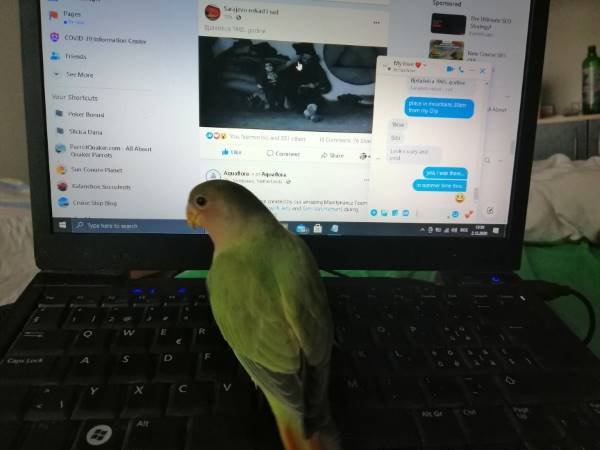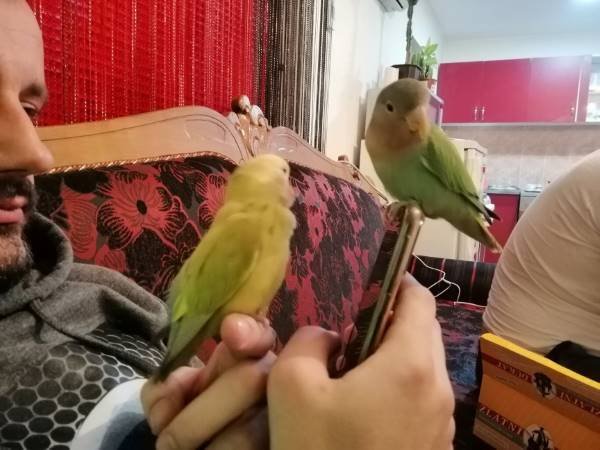Lovebirds hatch altricial chicks (featherless, blind, deaf, and dependent on their caregivers.) The rearing of chicks is an intensive process that requires a lot of time and dedication.
After the clutch has been laid, the female Lovebird will sit on the eggs to incubate them. During this time the males will feed their mate. Both parents work together to provide food to the hatchlings.
In the wild, chicks are reared in nesting hollows which are small and dark. The small space keeps them immobile and reduces the possibility of injuries due to excessive movement. In particular, damage can be caused to the long bones and cause bowing and rotation if they are allowed to move around too much.
| Species | Clutch size | Incubation period (days) | Fledging age (days) | Weaning age (days) | Sexual maturity |
| Lovebirds (Agapornis spp.) | 7–8 | 22–23 | 35–40 | 45–55 | 6–12 months |
Read more about Lovebird Breeding Process.
Reasons for hand-rearing baby lovebirds
Some bird owners choose to hand rear chicks. Reasons for this may include:
- To take over from poor parents – some may neglect some or all of their babies, or they can sometimes eat them
- To take over if parents have died
- To reduce the exposure to possible diseases in the aviary
- To increase production of chicks (the female will begin laying again if she has no baby to care for)
- To produce tame, friendly pets that enjoy human company
When to start hand-rearing baby lovebirds
If the eggs are artificially incubated, you will need to start the hand-rearing process as soon as the eggs hatch. If possible, it is best to leave the parents to care for the chicks for the first 2-3 weeks before you begin to take over. Some people decide to take the chicks from the nest and take over 100% of the care at this point. Others take the chicks for a small amount of time each day to feed them and get them used to humans, before returning them to the nest. This allows them to experience social interaction with humans and learn and retain natural bird behavior.
What to feed baby lovebirds
Ideally, a good-quality commercial hand-rearing formula should be used to feed the chicks. It is possible to make homemade recipes, but achieving a balanced diet is challenging.
The food should be heated to the body temperature of birds which is approximately 40-41ºC. A microwave is not recommended as this can produce hot areas in the liquid, potentially burning the crop.
Bacteria and yeast grow very quickly in the formula, even when kept in the fridge. Only enough for one feed should be prepared at a time.
You will need a set of accurate digital scales to measure the food (these will also be useful for weighing the chicks) and a container for measuring the water.
How to feed baby lovebirds
Lovebird chicks can be fed using syringes, spoons, or feeding tubes (also known as crop needles). It is crucial to perform strict hygiene measures and ensure all equipment is cleaned and sterilized between uses.
Closely follow the feeding guide for the formula you are using. Use a disinfected container to mix the formula with the correct amount of hot water and stir thoroughly. Water should be boiled before use to kill bacteria. Allow the mixture to cool to 41°C before feeding – a thermometer should be used to check the temperature.
If using a tube, you must take care to avoid damaging the crop wall if the chick is vigorously bobbling its head. There is also a risk that the tube could detach from the syringe and be swallowed by the chick. Always ensure it is securely attached to the syringe.
You must always place the syringe on the left side of the chick’s beak and dispense the food into the right side of the mouth. This is where the oesophagus (feeding tube) is located. The trachea (windpipe) is located on the other side. If the syringe is pointed in that direction, you risk them accidentally aspirating the food into their lungs.
How often and how much to feed
Newly hatched chicks need feeding every two hours, including during the night. Eventually, when fully feathered, they will only need to be fed every eight to twelve hours.
The chart below details the recommended feeding frequencies for chicks according to age.
| Age | Feeding regime |
| Recent hatchlings | Every 2 hours, throughout night |
| Unfeathered chicks | Every 4 hours, stopping for 6 hours during night |
| Chicks with some pin feathers | Every 4–6 hours |
| Fully feathered chicks | Two to three times daily |
| Weaned chicks | Not needed |
Source: Chitty, J., Monks, D. and British Small Animal Veterinary Association (2018). BSAVA manual of avian practice: a foundation manual. Gloucester: British Small Animal Veterinary Association, Cop.
The amount to give at each feed should generally be 10-12% of the chick’s bodyweight. It is essential not to feed too much as they may regurgitate the food and risk aspirating it into their lungs. You should check the crop before each feed to ensure it is nearly empty.
Weaning Lovebird Babies
Lovebirds babies wean at approximately 45-55 days. The amount and frequency of feeding should be reduced and, at the same time, begin to offer a variety of foods and fresh water. (Pellets, seeds, vegetables, and fruit). The food should be presented in a flat dish that will allow the chick to explore the food, play with it and taste it. As the amount of food, the chick is eating on their own increases, the amount of formula can decrease. The evening feed should be the last one to be dropped.
How to house Lovebird babies
The chicks should be kept in small dark containers to mimic the conditions of a nest. They need to be kept contained until they have reached fledgling age (approximately 35-40 days). The substrate (bedding) chosen should be absorbent, non-toxic and not easily ingested. Paper towels or recycled paper cat litter are good options.

Heating needs to be provided. Suggested temperatures according to age are provided in the chart below. Ideally, the environmental temperatures should be monitored with a thermometer that records maximum and minimum levels.
| Age | Brooding temperature (°C) |
| Recent hatchlings | 33–34 |
| Unfeathered chicks | 32–33 |
| Chicks with some pin feathers | 29.5–32 |
| Fully feathered chicks | 24–29.5 |
| Weaned chicks | 20–24 |
Source: Chitty, J., Monks, D. and British Small Animal Veterinary Association (2018). BSAVA manual of avian practice: a foundation manual. Gloucester: British Small Animal Veterinary Association, Cop.
A bowl of wet cotton wool should be placed in the container and changed daily to provide humidity.
Environmental enrichment should be provided once the chicks reach fledgling age to encourage them to develop natural foraging behaviors. This is not achieved if the food is simply supplied in a bowl.
Potential issues when hand-rearing lovebird babies
The babies should be monitored daily for growth and any signs of ill health. Record their weight on a chart so any trends can be identified.
Potential health issues include:
- Aspiration can occur when food or liquid is inhaled into the lungs rather than entering the oesophagus. The risk can be reduced by not overfeeding and ensuring feeding tubes or syringes are always placed on the left side of the chick’s beak.
- Crop infections – this is usually due to poor hygiene. Signs of this include crop stasis (when the crop fails to empty), weight loss, lack of interest in food and quietness.
- Dehydration – This can become an issue if not enough water is added to the formula when mixing.
- Hypothermia – If the chick feels cold to the touch or is shivering, it is probably too cold. Some brooders have forced warm air, which can contribute to dehydration. Care should be taken when using these methods of warming.
- Crop burn – If the temperature of the formula given is not hot enough, the chicks will probably refuse to eat. It will make them cold and can predispose them to crop stasis. If it is too hot, it can burn the lining of the crop. Even formula given at 45-46°C is enough to cause damage to the crop wall. It can also happen if a microwave is used to heat the formula because it can cause ‘hot spots’ that are higher than the suggested temperature of 41°C.
- Gastrointestinal foreign bodies – These can occur if the feeding tube is not securely attached to the syringe and is accidentally swallowed by the chick. There is also the risk of the chicks eating toys and other objects such as bedding as they get old and more inquisitive about their environment.
References
Chitty, J., Monks, D. and British Small Animal Veterinary Association (2018). BSAVA manual of avian practice: a foundation manual. Gloucester: British Small Animal Veterinary Association, Cop.
Hari. (n.d.). Psittacine Pediatrics: Housing and Feeding of Baby Parrots. [online] Available at: https://hari.ca/hari/research-facility/hari-research-papers/psittacine-pediatrics-housing-feeding-baby-parrots/.
Sandiegozoo.org. (2019). Fischer’s Lovebird | San Diego Zoo Animals & Plants. [online] Available at: https://animals.sandiegozoo.org/animals/fischers-lovebird.
Small Animal, Pet Bird, and Wild Bird Supplies: Pet Supplies | Kaytee Products. (n.d.). Hand Feeding. [online] Available at: https://www.kaytee.com/learn-care/pet-birds/hand-feeding [Accessed 14 Aug. 2022].




